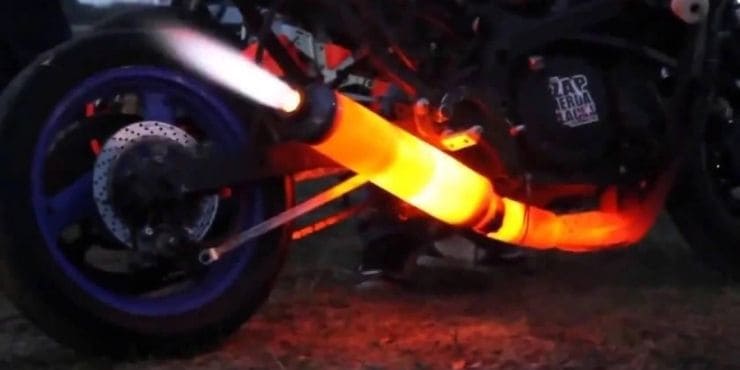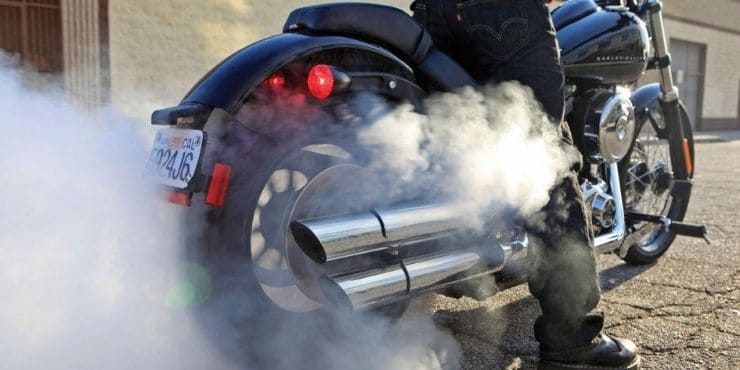Have you ever accidentally touched an exhaust and burnt your hand? Most people who own a motorcycle have probably experienced this. Has it made you think, how hot does motorcycle exhaust get? If so, then you will get the answer here.
Motorcycle exhaust temperatures can reach between 300°F to 1,600°F depending on engine load and throttle use. The headers near the engine are the hottest, while the muffler area cools down further back.
In this article, you’ll get to know all about motorcycle exhaust temperatures, how hot does motorcycle exhaust get, and how the exhaust can overheat among other things. Continue reading to know more.
How hot does motorcycle exhaust get?
The Harley-Davidson bikes have the engine power produced by burning gas. The maximum portion of the power will be produced and used for running the Harley-Davidson bikes. At the same time, the rest will be eliminated through the bike’s exhaust pipe.
The cans will get hot enough to burn your skin, but will still be a lower temperature than the rest. The highest temperature that a Harley-Davidson engine exhaust can reach would be around 850° C. The metals will start turning red at 500° C and would be a dark cherry red color around 650° C.
In the Harley-Davidson bike’s engine chamber, the gasoline will be in compressed form. At around 1600° F, the gasoline will start burning. It can be estimated that the temperature inside the exhaust will remain around 1600° F. In Harley-Davidson bikes with Exhaust Gas Recirculation (EGR), the temperature will be around 1400° F – 1600° F.
Temperatures in the exhaust pipe
If you’re looking closely, the exhaust’s pipe head is normally narrower than its body. When the gases in the exhaust are leaving through the pipe, they’ll be concentrated at the head. If you’re wondering how hot the exhaust pipe gets, it’s seen that the exhaust can go 700 degrees.
Depending upon how the exhaust transfers heat outside, the exhaust pipe’s temperature will vary. The temperature will be based on a wide variety of engines and the weight the bike is carrying. The temperature will be lower if there is an infrared red gauge present. The average temperature range of exhaust pipes is between 700 – 1400° F. The 1400° Ftemperature is exceedingly high and capable of heavily damaging and burning the skin. Sometimes, the exhaust pipe temperature could cross the limits and even melt the pipe.
Heat production
When you’re riding a bike, the engine will produce the power using gasoline. The exhaust pipe will remove the heated waste gas from the bike before releasing it out into the atmosphere. The volume of the exiting temperature will be quite high. So, it is almost impossible to calculate the exhaust gas’ volume accurately, let alone calculate the exhaust pipe’s temperature. You will need to properly understand how the muffler and gas exhaust system works when the bike isn’t moving. You can even notice the exhausting system as a whole and how the waste gas is flowing through the pipe.
The pipe leading to the carburetor heats up as soon as you’re starting the bike. After a while, the tailpipe will start sparkling as well. The muffler and exhaust system on the bike will then start filtering a stream of hot air. However, after the air passes the fuel system, you’ can be assured that it’ll start cooling.
Surprisingly, the amount of heat created in the bike’s exhaust will be almost the same. The oxygen sensor will become heated very quickly. It could very well be the hottest area in the total system. Air will start flowing down the catalytic converter, where it’ll be blown out with exhaust gases. The entire region gets quite heated as a result of this process.
Tips to prevent accidents related to exhaust system overheating
If you know how hot does motorcycle exhaust get, you’ll know that it’s neither good for you nor your bike. The temperatures can get exceedingly high, and they can easily result in burns or overheating issues in your Harley-Davidson motorcycle. Simultaneously, it means that you need to take the necessary precautions. The precautions will help you nor by anyone in the vicinity to avoid injuries or burns from the exhaust. What most Harley-Davidson riders aren’t aware of is that the exhaust burns are highly dangerous.
In fact, these burns will be one of the least understood injuries in the motorcycle riding community. The serious injuries you could sustain or may sustain will probably make you think if you could have done something. This will be a big enough incentive to know why you should prevent overheating and protect yourself.
Most of these burns occur when you accidentally touch the exhaust pipe or the muffler or any component nearby. Such contact could potentially lead to severe burns. In a study, it was discovered that most accidental bike injuries occur when the rider is getting off the bike. The most common spot for burns will be right below the knee. Here are a few tips that you should keep in mind to protect yourself from exhaust burns.
- Use a heat shield for exhaust pipes. You can use one that will wrap up the hot exhaust pipe.
- Be careful when you’re starting your motorcycle.
- Ensure that you do not come into contact with a hot muffler when you’re moving the bike or picking it up.
- When you’re driving with a child, you should be extremely cautious. Kids are very hyperactive, and they’re more at risk of suffering burns from the motorbike exhaust.
- Remember to clean your bike’s exhaust or tailpipe every now and then using soap.
- Make use of metal polish for removing the dirt on the stainless-steel exhaust pipe’s wall.
- If you have to touch the exhaust pipe for some reason, make sure that you let it cool down first.
- Motorcycle exhaust systems can sometimes become loose because of vibration when you’re driving. So make sure that all the screws and bolts are tightly fit.
It is important to know that burn remedies will differ depending on the severity of the burn. The most common burns from exhaust pipes will be second or third-degree burns. The symptoms of most of these burns likely get diminished in about 20 days. If you still feel pain after you’ve been burnt, it is a positive sign, and you’ll be fine in a few days.
However, remember to seek medical treatment if the burnt part becomes numb. This is an indication that the burn is severe and needs treatment at a hospital. The majority of exhaust burns and injuries occur during hot summers. The reason is that both the interior and exterior temperature will be quite high. The exhaust will hardly have any time to cool down. This is why you must be careful of hot exhaust pipes and prevent yourself from accidentally touching or contacting them.
Possible reasons for overheating in the motorcycle exhaust
While the exhaust functions at a pretty high temperature, it doesn’t take long for it to go over the edge. The exhaust in a Harley-Davidson bike can overheat due to many reasons. As the components are interconnected, even a small issue in one of the components could cause the bike to overheat.
One of the biggest reasons for the exhaust heating in a bike is the heat during the summer season. When the bike is being driven, the exhaust is already fairly hot. When it is idle, the heat during the summers will not give the exhaust enough time to cool down. If you ride for too long or ride too frequently, the engine could overheat due to not having enough time to cool down.

Having a faulty cooling fan thermostat
The thermostat on the cooling fan is a switch that will close the cooling fan circuit once the coolant has reached a certain temperature. Once the fan is activated, it’ll greatly increase the flow of air in the radiator.
This way, it’ll help reduce the temperature of the coolant and help the heat evacuate from the exhaust and engine. This is one of the reasons why you’ll hear the fans in the vehicles turning on and off intermittently as you’re standing in traffic during summers. In case the thermostat on your motorcycle fails, the fan will not switch on. Hence, the temperature will continue rising. The good news for you is that a thermostat is fairly cheap and easy to fix.
Having a damaged radiator core
Have you ever seen a motorcycle with wafer-thin elements of the radiator core all malformed and bent over? The chances are that it was cleaned with a strong jet wash to remove bugs and dirt during summers. The radiator core is made using an incredibly soft material, likely aluminum. The benefit of that is the amazing heat sink properties. This makes aluminum an ideal material for transferring heat away from the bike and into the air.
The potential downside is that it can be very easy to bend over the fins on the edge of the radiator. This will prevent the air from flowing out and overheating the motorcycle’s components. The better option for removing the bugs and dirt from the radiator is to soften them through soapy water. Then you can use a soft brush and dislodge the muck.
Low fluid level
It may not sound a big deal, but not having enough fluid in the coolant circuit is a huge issue. For starters, it can cause overheating issues. The air isn’t a good enough coolant medium unless it is flowing over the external cooling fins. You should keep the bike’s fluid levels at the optimum level to maintain the right temperature. Further, you shouldn’t just use water. Instead, you should be using a mixture of water, coolant, and anti-freeze. The coolant will help in raising the boiling point of the fluid. This, when combined with the pressurized system, will help in preventing overheating.
Conclusion
Thank you for reading. Hopefully, now you have a better idea about the temperature situation in motorcycle exhausts and how hot does motorcycle exhaust get. In Harley-Davidson motorcycles, the exhaust can reach temperatures as high as 850° C. Meanwhile, the metals will start turning red at 500 °C while it could turn dark cherry red around 650° C. Make sure that you avoid overheating the exhaust and never try to touch it; otherwise you could be left with second or third-degree burns.

